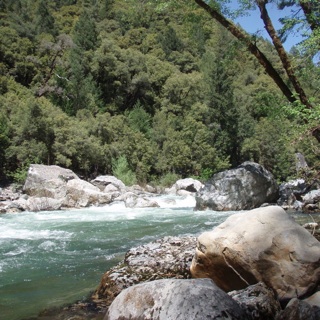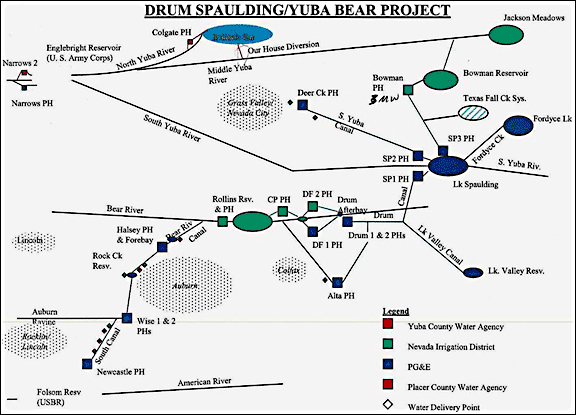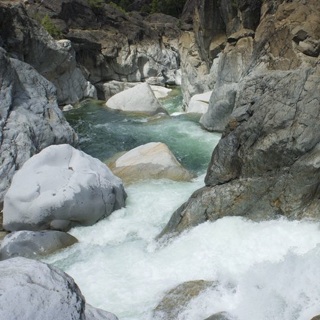 The South Yuba River was the birthplace of the hydropower industry in California in the late 1890’s. It should be no surprise then that hydroelectric projects today on the Yuba River and the Bear River watersheds make up the largest and most complex configuration of hydroelectric plumbing in all of California. The Middle Yuba, South Yuba and Bear River Watersheds are impacted by numerous hydroelectric projects – some which are subject to license by the Federal Energy Regulatory Commission (FERC), and some that are exempt. Since 2006, American Whitewater has been an active participant in negotiating new license terms and conditions for three of these projects - the Yuba/Bear Hydroelectric Project, operated by the Nevada Irrigation District (“NID”) (FERC #2266), the Drum Spaulding Hydroelectric Project, operated by Pacific Gas & Electric (“PG&E”) (FERC #2310), and the Yuba River Development Project, operated by the Yuba County Water Agency (“YCWA”) (FERC #2246). The Yuba/Bear and Drum Spaulding licenses are both due for renewal in 2013, and relicensing negotiations are happening jointly. The YCWA project license is due for renewal in 2016.
The South Yuba River was the birthplace of the hydropower industry in California in the late 1890’s. It should be no surprise then that hydroelectric projects today on the Yuba River and the Bear River watersheds make up the largest and most complex configuration of hydroelectric plumbing in all of California. The Middle Yuba, South Yuba and Bear River Watersheds are impacted by numerous hydroelectric projects – some which are subject to license by the Federal Energy Regulatory Commission (FERC), and some that are exempt. Since 2006, American Whitewater has been an active participant in negotiating new license terms and conditions for three of these projects - the Yuba/Bear Hydroelectric Project, operated by the Nevada Irrigation District (“NID”) (FERC #2266), the Drum Spaulding Hydroelectric Project, operated by Pacific Gas & Electric (“PG&E”) (FERC #2310), and the Yuba River Development Project, operated by the Yuba County Water Agency (“YCWA”) (FERC #2246). The Yuba/Bear and Drum Spaulding licenses are both due for renewal in 2013, and relicensing negotiations are happening jointly. The YCWA project license is due for renewal in 2016.
The Yuba and Bear Rivers spring from the western Sierra Nevada Mountains and flow into the Feather River at Yuba City. These neighboring watersheds offer stunning scenery and amazing opportunities for recreation. Historically, these rivers were home to Chinook salmon, steelhead trout, the Foothill Yellow-legged frog, and numerous other species. Rivers affected by the Yuba/Bear, Drum Spaulding Hydroelectric and YCWA projects include some of the crown jewels of California whitewater, such as the Class IV Edwards to Purdons and Highway 49 to Bridgeport runs on the South Yuba, and the Class V Fordyce Creek. These and other High Sierra classics are described well in Darin McQuiod's River Directory.
 Unfortunately, flows on these rivers are anything but predictable and reliable for aquatic species and whitewater enthusiasts. There is little wonder about this when one considers the magnitude of the hydroelectric projects that impact these systems from just these two hydro projects alone. The Yuba-Bear Project, constructed in the 1960’s for water supply and power production, has 9 on-stream reservoirs, 3 off-stream impoundments, 2 diversion dams and 4 powerhouses. The Drum Spaulding Project spans the South Yuba, the Bear, the North Fork of the North Fork American River (the American River watershed neighbors the Bear River Watershed to the south), and numerous related tributaries. Drum Spaulding has a whopping 29 reservoirs, 12 powerhouses and 3 diversion dams. To the north, the YCWA project consists of 3 large dams on the North and Middle Yuba rivers. Together, these projects capture about 80% of the snowmelt at the top of the watersheds and divert it out of the basin, leaving little flow available for aquatic life throughout most of the year. In the spring, when the projects are spilling, flows can drop dramatically from over a thousand cfs to little flow in a short period of time, harming the riparian ecosystem.
Unfortunately, flows on these rivers are anything but predictable and reliable for aquatic species and whitewater enthusiasts. There is little wonder about this when one considers the magnitude of the hydroelectric projects that impact these systems from just these two hydro projects alone. The Yuba-Bear Project, constructed in the 1960’s for water supply and power production, has 9 on-stream reservoirs, 3 off-stream impoundments, 2 diversion dams and 4 powerhouses. The Drum Spaulding Project spans the South Yuba, the Bear, the North Fork of the North Fork American River (the American River watershed neighbors the Bear River Watershed to the south), and numerous related tributaries. Drum Spaulding has a whopping 29 reservoirs, 12 powerhouses and 3 diversion dams. To the north, the YCWA project consists of 3 large dams on the North and Middle Yuba rivers. Together, these projects capture about 80% of the snowmelt at the top of the watersheds and divert it out of the basin, leaving little flow available for aquatic life throughout most of the year. In the spring, when the projects are spilling, flows can drop dramatically from over a thousand cfs to little flow in a short period of time, harming the riparian ecosystem.
The FERC relicensing process for the Yuba/Bear, Drum Spaulding and YWCA Hydro Projects offers a unique opportunity to ensure that the operation of these projects support aquatic and riparian ecosystems as well as whitewater recreation. American Whitewater has been and will continue to be an advocate for these values throughout the process. We believe that what is best for the river is also good for recreation, and are advocating for a flow regime in the system that will mimic the natural patterns of increased flows in the spring with snowmelt that gradually tapers to summer base flows over the course of several weeks or months. This “snowmelt recession hydrograph” is an important trigger in the life cycles of riparian species and supports whitewater recreation. This type of flow regime is gaining traction with state agencies and local utilities on this and other projects in the state, including the McCloud, Feather and Middle Fork American Rivers.
 Beginning in 2008, American Whitewater, PG&E, NID, and YCWA began conducting flow studies, enabling us to gather important information about minimum acceptable and optimum recreation flows on twenty river reaches on the North Yuba, Middle Yuba, South Yuba, and Bear Rivers, and Fordyce Creek. Boaters participated in an opportunistic flow study and then filled out surveys online about their experiences. The studies on the Yuba/Bear and Drum Spaulding projects were completed in 2010, and the YCWA flow studies wrapped up a couple of years later. The information gathered in these studies helped us evaluate the effects of the Projects on whitewater boating and define flow needs in the new license. A key piece of this process involved getting the utilities to provide real-time flow information on all of the river reaches in the project. AW’s participation in the Relicensing process has resulted in about a dozen additional gauges, and information from them is available online through American Whitewater’s website and at Dreamflows.
Beginning in 2008, American Whitewater, PG&E, NID, and YCWA began conducting flow studies, enabling us to gather important information about minimum acceptable and optimum recreation flows on twenty river reaches on the North Yuba, Middle Yuba, South Yuba, and Bear Rivers, and Fordyce Creek. Boaters participated in an opportunistic flow study and then filled out surveys online about their experiences. The studies on the Yuba/Bear and Drum Spaulding projects were completed in 2010, and the YCWA flow studies wrapped up a couple of years later. The information gathered in these studies helped us evaluate the effects of the Projects on whitewater boating and define flow needs in the new license. A key piece of this process involved getting the utilities to provide real-time flow information on all of the river reaches in the project. AW’s participation in the Relicensing process has resulted in about a dozen additional gauges, and information from them is available online through American Whitewater’s website and at Dreamflows.
In late 2014, FERC issued the Final Environmental Impact Statement for the Project, and agreed to virtually all of the conditions that we negotiated during the relicensing process. We're looking forward to the implementation of improved flows on over 110 miles of some of the best whitewater runs in California. These flows will drop gradually after spill events in the spring, mimicking the natural hydrograph. This will not only enhance the whitewater boating season and provide predictability of flows, but will also be protective of aquatic species. We expect the final license to be issued in 2016.
American Whitewater is representing your interest in seeing a healthier Yuba and Bear River system. We will continue to do so until the new license is finalized and beyond into implementation.
